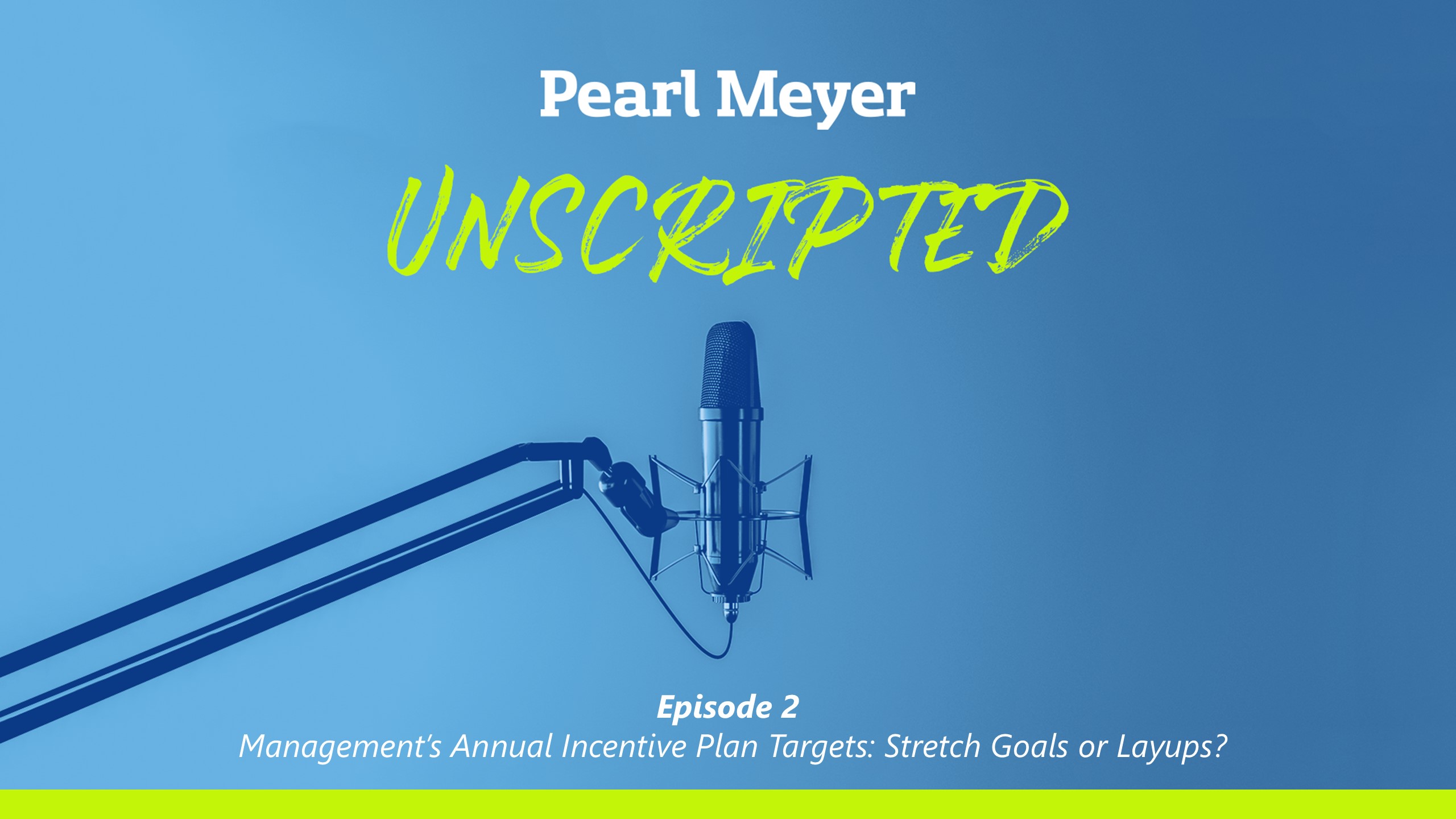
Podcast | Jun 2025 | The Pearl Meyer Unscripted Podcast
Management's Annual Incentive Plans: Stretch Goals or Layups
S1 Ep 2: How to smooth out potential tension between the board and management around rigor of the annual incentive plan targets.
Transcript
Jake: Is it a problem if the annual incentive plan pays out over target every year? Hello, and welcome to Pearl Meyer Unscripted. I'm Jake George, CMO at Pearl Meyer, and we're happy you found our new podcast. In this first season, my colleagues, Mark Rosen and Alap Shah are exploring different aspects of executive compensation planning in an uncertain economic environment. Today, they're talking about the rigor of annual incentive plan targets and how to get management and the board on the same page.
Mark: Hey, Aalap, how you doing today?
Aalap: Doing well, Mark. How's it going? What's up?
Mark: It's good. Do you have a moment because I just got this call from management, and we've got this board member who is pushing back really hard on the annual incentive plan targets. And I mean, I don't know that she's wrong, but she really wants the target to be greater than last year, but there's so much uncertainty as we go into the year. She also thinks that management sandbags. They have paid over target every year, but frankly their stock price has been growing faster than everybody else in their sector. They clearly outperform their peers and last year was a great year. They maxed out, but it was really due to some cost savings that they don't think will reoccur. And they think that the plan for this year is a stretch. So, I'm just wondering if you've got any advice for me because I've been trying to deal with this for a while now.
Aalap: Yeah, I would definitely be more concerned if they're hitting max and their total shareholder return isn't beating peers or it's going the other way, right? So I think, you know, maybe there's still a potential for sandbagging, but that it seems, you know, less possible. One of my other clients, what they do, who has had a pretty good run for a few years, is that when they are presenting the annual incentive results, they talk about total shareholder return, they talk about market share, they talk about other metrics that are not in the annual incentive plan relative to their peers. So, I think that's first and foremost, that's something that you could put forward to your director and have management prepare that because there is oftentimes a narrative around why payouts have been above target.
Mark: Yeah, that's good advice. They track those things, but it's unclear how often that they are sharing that with the compensation committee. I know that they share it internally all the time because they're tracking it and they really have been beating everybody else on most of those metrics. So, I think that the payouts have really been commensurate with the performance in the past. One of the things I did is I asked them to do a little sensitivity analysis on the forecast to say, you know, what could happen and what have they already built in? Because a lot of times when, and I hate to use the term sandbag because I really don't think management teams sandbag, but what they've done is they have shown what could go right and what could go wrong and placed us, I mean obviously there's a little, there's risk that some things could go better than they expect and risk that some things could go worse. Well, they've identified what some of those things are and then shown how it would flow through the financial statements and specifically how it would hit EBITDA because they use EBITDA as their financial metric.
Aalap: Yeah, I think that's a really powerful tool to put in front of a committee. Because again, you know the committee members are trying to digest this information and they don't always have all the information that the management teams have. So management teams may have it in their head and things like that. But the more we display the thinking that's gone into the goal-setting process, I think the better for everybody. And so I definitely have clients that tend to show, this is the low case, this is the clinical budget case, and then this is the high case, and display that sensitivity. Along with that, and this is where I think people like us, Mark, can you know, can help out, is doing a probability of attainment analysis. So, I don't know if you do that at your organization, but this is basically taking the goals that they're putting forward and testing what is the probability that these goals would be attained. And so you test this against the historical financials of the company, you test this against the historical financials of the peers. I've even done this on perspective. Depending on the metric, analysts' estimates are available to test that against the both the peers as well as the company. And you put all that data together and what you can actually analyze is that how robust, how stretch are the goals. And generally speaking, you'd want that target goal to be something that has a probability of about 50 to 60% of the time of the attainment, having the threshold goal be something that's about 80 to 90% probable to be attained, and then the max payout to be something that is 10 or 20% likely so it creates this nice bell curve distribution. So along with that sensitivity analysis, I think having this sort of external analysis of probability attainment really is helpful as well.
Mark: Yeah, that's something that we talk about with them. We really want to ask the question, does management feel that the target is reasonable and achievable? It needs to be a stretch. It needs to not be a layup. But we want to make sure that we can communicate it within the organization. The issue is they come in and they say, yeah, this is reasonable and achievable, we're comfortable with this. And then the committee continues to push them and then they turn around and they beat it. So I think this management team really is performing, but they get nervous about setting targets that have too much stretch in it. So I think that it's helpful to run those sensitivity analyses because you can really be management or board agnostic, but play it down the middle and say, you know, here's some data that would suggest how this will be achieved and what the likelihood of this achievement is and get both sides feeling as though that information is reasonable and nobody's trying to sandbag each other.
Aalap: Right, because I mean, I think, again, going back to sort of the more information, the better, because I think that helps sort of calm nerves and really get to the conclusion of what should be the appropriate goals. You know, other thing that I don't know if this is part of your issue, but what do you think about setting a flat part of the curve, you know, around target? So, if the target is something that is maybe not deemed super aggressive, you could have a flat part of the curve where payout is still 100%, even if they slightly exceeded that target. Do think that would help in this situation?
Mark: It does. I've used that before and you know, the pushback I've gotten on that is once I get to target, there's no more incentive for me until I hit another 2%. And I always have to remind people that we did this because of the uncertainty around the target setting to ensure that you would potentially get it if you were off of target by just a little bit. So it's got to cut both ways. If you were 2% under target and you still got 100%, 2% over target is still reasonable. But it also makes the, if you keep the threshold and the maximum the same, it also makes that curve steeper or it's not really a curve, it's really a straight line typically, but it does make it a little steeper above and below.
Aalap: No, absolutely. And I think it does tend to drive performance higher when you have that flatness. And as you said, it cuts both ways. And so I always like that flatness part of the curve because it gives you some downside protection. But then in a fair way, you're giving up some potential upside and now what's interesting about that, the conversation I've had about that flatness and something to explore with your client is how wide do you make that flat part of the curve? Because as we know, most, depending on the metric, most incentive programs establish threshold at either 80 or 90% of target and a superior somewhere between 10 and 20% of target. If the flat part is too wide, you're sort of cutting into the threshold and the experience. That's something to watch out for with other clients, we've had a lot of conversation around how wide do you want to have that flat part be?
Mark: So these guys also are 100% financial metric-driven in their annual plan and I've been pushing for them to have some non-financial to take the sting out of either overachievement or underachievement on the annual incentive. What's your experience in using some non-financial metrics to mix into the annual plan to help dampen that and potentially get people more comfortable with the financial targets?
Aalap: See Mark, I knew you're smart. I love that. I'm not sure why they're not listening to you. I view everything as about balance and there may be years where a 100% financial is the right thing to do, but having that as just your default that goes unchanged, I think, you know, companies are not serving themselves in the proper way when they do that. So I'm a big proponent of thinking about the year, thinking about what you want to accomplish in the year and creating the metrics around that. So, having for your particular client, I think this issue about outperforming the financial targets and the issues around goal-setting and potential sandbagging, I think a lot of that gets remedied by having some strategic non-financial metrics that are part of that short-term plan. And if you do that and give it its, you know, appropriate weighting then you have an ability to really test against that financial performance and make sure the company is moving in the forward direction that it should be. Because the management team is definitely working on a lot more things than just delivering on the financial results.
Mark: Yeah, I always think about those non-financials as how you got the financial results and did you do it in the right way. But I also find that non-financial targets, no matter what they are, tend to pay out near target. Is that your experience?
Aalap: They do, right? I think it is definitely dependent on what that non-financial metric is, but because it's something that you're assessing against the accomplishment of a strategic goal, there tends to be actually, you know, significant more scrutiny. So this is where, one of the things I'm reading between the lines with your director, there seems to be a little bit of, you know, a sense of like loss of control in understanding whether or not the goals are aggressive enough. Having some non-financial plus strategic measures into the mix, I think provides a little bit more control for the committee as well to make sure that the management team is being held accountable for those outcomes that will then lead to future value creation.
Mark: I think you're right. I think there is a little bit that going on. I do find sometimes that boards and comp committees don't really want to evaluate non-financial performance because it makes them have to take a stand with respect to the overall performance. They're much more comfortable when management is able to come and say, here's how we did, here's how we performed against these strategic objectives or whatever it is, and here's what we believe the payout ought to be, and then they can agree or move the needle a little bit. This has been really helpful. It also applies to long-term incentives, especially those financial metrics that are not relative. So, if you don't mind, I'd love to bend your ear a little bit on some of that.
Aalap: Yeah, that would be great, Mark. Happy to do it.
Mark: Okay, have a good rest of the day. See ya.
Aalap: All right, take care, bye.
Jake: And there's our setup for next time, a discussion on financial metrics and long-term incentives. Be sure to look for new episodes each week on Spotify, Pearlmeyer.com, or wherever you get your podcasts.
Look for new episodes each Monday afternoon at Pearl Meyer Unscripted, subscribe to our YouTube Channel, and listen on Spotify.


